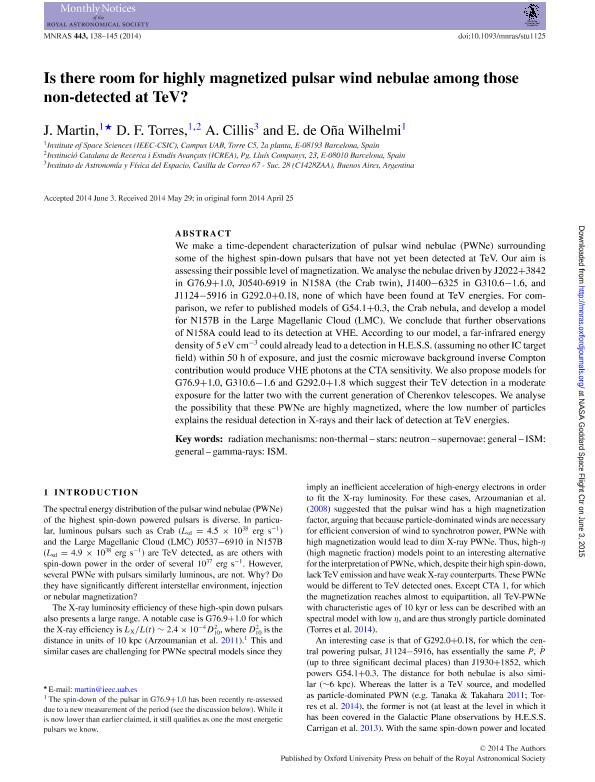Artículo
Is there room for highly magnetized pulsar wind nebulae among those non-detected at TeV?
Fecha de publicación:
09/2014
Editorial:
Oxford University Press
Revista:
Monthly Notices Of The Royal Astronomical Society
ISSN:
0035-8711
Idioma:
Inglés
Tipo de recurso:
Artículo publicado
Clasificación temática:
Resumen
We make a time-dependent characterization of pulsar wind nebulae (PWNe) surrounding some of the highest spin-down pulsars that have not yet been detected at TeV. Our aim is assessing their possible level of magnetization. We analyse the nebulae driven by J2022+3842 in G76.9+1.0, J0540-6919 in N158A (the Crab twin), J1400-6325 in G310.6-1.6, and J1124-5916 in G292.0+0.18, none of which have been found at TeV energies. For comparison, we refer to published models of G54.1+0.3, the Crab nebula, and develop a model for N157B in the Large Magellanic Cloud (LMC). We conclude that further observations of N158A could lead to its detection at VHE. According to our model, a far-infrared energy density of 5 eV cm-3 could already lead to a detection in H.E.S.S. (assuming no other IC target field) within 50 h of exposure, and just the cosmic microwave background inverse Compton contribution would produce VHE photons at the CTA sensitivity. We also propose models for G76.9+1.0, G310.6-1.6 and G292.0+1.8 which suggest their TeV detection in a moderate exposure for the latter two with the current generation of Cherenkov telescopes. We analyse the possibility that these PWNe are highly magnetized, where the low number of particles explains the residual detection in X-rays and their lack of detection at TeV energies.
Archivos asociados
Licencia
Identificadores
Colecciones
Articulos(IAFE)
Articulos de INST.DE ASTRONOMIA Y FISICA DEL ESPACIO(I)
Articulos de INST.DE ASTRONOMIA Y FISICA DEL ESPACIO(I)
Citación
Martín Rodriguez, Jonatan; Torres, Diego F.; Cillis, Analia Nilda; Wilhelmi, Emma de Oña; Is there room for highly magnetized pulsar wind nebulae among those non-detected at TeV?; Oxford University Press; Monthly Notices Of The Royal Astronomical Society; 443; 1; 9-2014; 138-145
Compartir
Altmétricas




